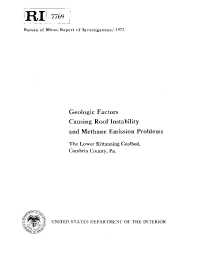Mining Publication: Geologic Factors Causing Roof Instability and Methane Emission Problems: The Lower Kittanning Coalbed, Cambria County, Pa
Original creation date: January 1973
A geologic study of Mines 32 and 33 in Cambria County, Pennsylvania, was conducted as part of a methane control research program. Areas of high methane emission and roof instability are encountered; these are related to the structural and stratigraphic features that characterize the geologic setting of these mines. Locally the folds trend N 20 deg E +/-2 deg, the direction of the butt cleat in the Lower Kittanning coal. The face cleat strikes at N 69 deg W +/-2 deg and the systematic rock joint in the surface bedrock strikes N 67 deg W +/-2. This suggests that a directional stress oriented N 70 deg W produced the folds and influenced the directions of coal cleat and systematic joint sets. Analysis of side-look airborne radar (SLAR) indicates three directions of prominent regional lineation: N 39 deg E, N 31 deg W, and N 70 deg W. Little gas was encountered during development mining; large volumes of gas are encountered when roofs fall. Most of the gas comes from strata above the mined coal; therefore, to control methane, roof instability must be controlled. Roof falls and high rates of methane emission are most likely where less than 30 feet of many thin layers of limestone, shale, and sandstone occur between the Lower Kittanning coal and the next coal and in zones along the margins of a sandstone channel.
Authors: CM McCulloch, M Deul
Report of Investigations - January 1973
NIOSHTIC2 Number: 10000623
Pittsburgh, PA: U.S. Department of the Interior, Bureau of Mines, NTIS No. PB-221518, RI 7769, 1973 Jan; :1-25
See Also
- Development and Application of Reservoir Models and Artificial Neural Networks for Optimizing Ventilation Air Requirements in Development Mining of Coal Seams
- Geologic Factors Influencing the Gas Content of Coalbeds in Southwestern Pennsylvania
- Guidelines for the Control and Monitoring of Methane Gas on Continuous Mining Operations
- Investigation of Methane Occurrence and Outbursts in the Cote Blanche Domal Salt Mine, Louisiana
- Managing Excess Gas Emissions Associated with Coal Mine Geologic Features
- Methane Content of Gulf Coast Domal Rock Salt
- Modeling and Prediction of Ventilation Methane Emissions of U.S. Longwall Mines Using Supervised Artificial Neural Networks
- Remote Methane Sensors
- Reservoir Modeling-Based Prediction and Optimization of Ventilation Requirements During Development Mining in Underground Coal Mines
- Reservoir Rock Properties of Coal Measure Strata of the Lower Monongahela Group, Greene County (Southwestern Pennsylvania), from Methane Control and Production Perspectives
- Content source: National Institute for Occupational Safety and Health, Mining Program


 ShareCompartir
ShareCompartir
